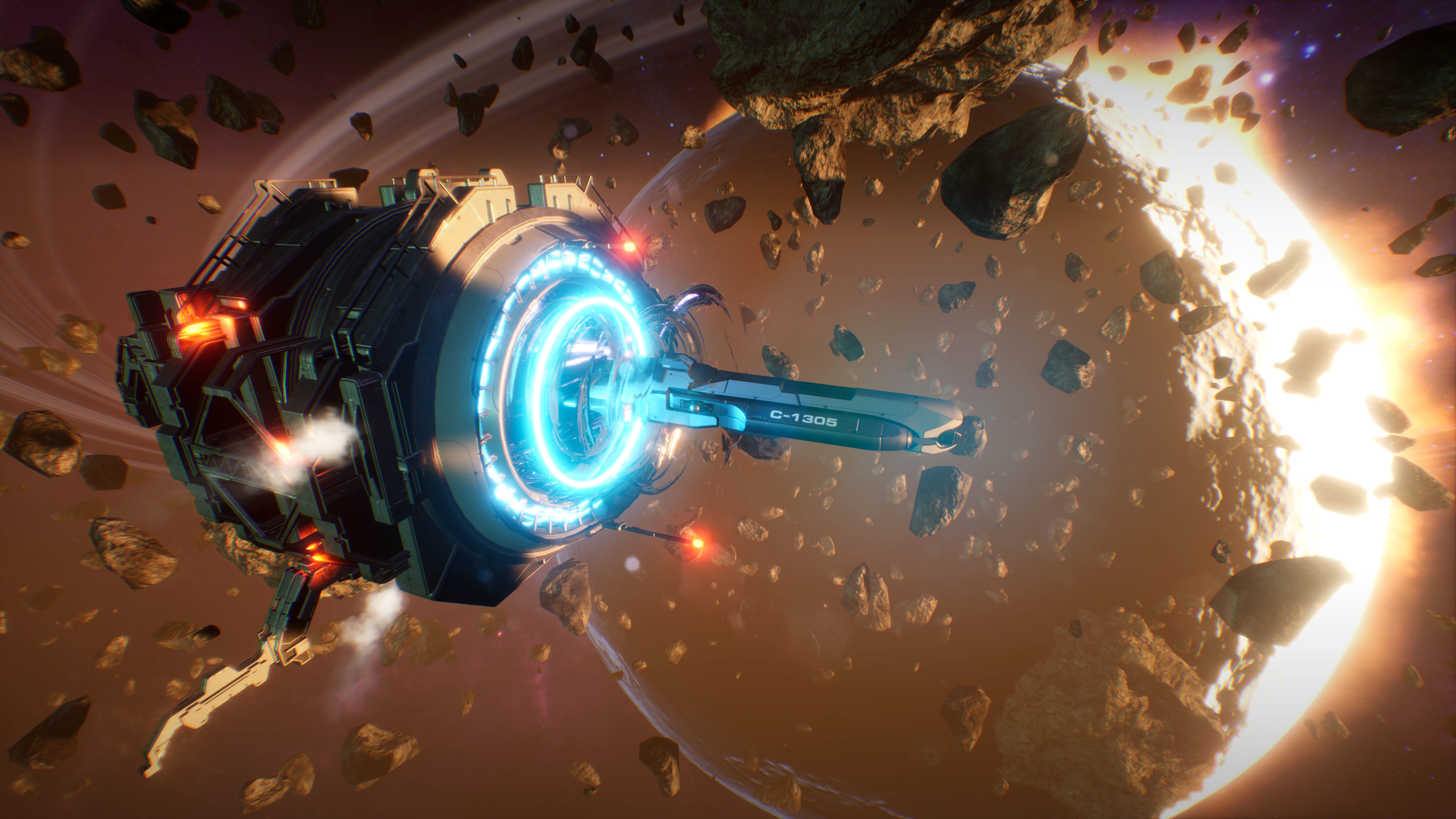Andromeda Playtest Build Updates

Now that the Game Developers Conference and E3 are behind us, the team has shifted out of “Demo Mode” and is back on track into full Production (we’re playing a little bit loose with our development terminology as we still have elements of the game that are in Pre-Production, but for all intents and purposes, we’re excited to start focusing on core features). Here is a quick overview of the things we’ve been working on to date:
- Visual updates galore
- Upgraded movement controls
Visual Effects: Weapons, Shields, and Thrusters
The team has upgraded our visual effects across four important space combat systems: damage states, weapons, shields, and thrusters.
Damage States
To improve the experience of vanquishing your foes, a new damage system has been implemented. This includes adding additional models with stressed elements to indicate what remains after a ship breaks apart. There are also other touches like smoldering metal that add visual flavor and contrast.
Weapons
For weapons, the rail gun, ion repeater, ion disrupter, gatling gun, missiles, flak cannon, and even cluster bombs received a level up in their visual quality. All of these names are currently a placeholder, but we’re using them as descriptors for the time being. Impact visual effects (VFX) for these weapons also received a polish pass.
Shields
Capital ship shields also received a VFX pass. The original shield was really just a semi-transparent mesh that changed color as it took more damage. Now, the system has several visual layers and includes a dynamic local response to indicate to the player where the shield is actually being impacted.
Thrusters

Mark Nicolino built in some basic emissives for the ship engines, which have a great ionic glow for an idle state, but there were no other effects applied to let players know when the ship was cruising or boosting with afterburners.
The community was having difficulty reading when the boosters were firing as the only indication was an energy bar in the HUD. The experience was lackluster and didn’t provide the visceral experience one would expect from powerpacked engines on a weaponized support ship. So we made an effort to improve readability by emphasizing the three different states. We also added some initial kickback in an attempt to really drive home the feeling of high thrust output.
Ship Battle Wear and Tear
Space is a hostile place and space combat ups the ante. The team has implemented the first version of our battle wear system. Mark has taken a pass on wear and tear progression so that a player’s flight and combat hours will cause a gradual degradation of a pristine support ship.

For now, however, players will get a chance to see the most severe form of the battle wear system (minus damage states, which exist but have yet to be included in an external build).
Vessel Movement System

When it comes to controls, Christian has an intuitive sense of how to approach iterating on the feel of gameplay. A competitive FPS and 3rd person combat player, Christian has mentioned that he’s not normally into space games. However, he has given himself the mission of creating a space combat control model that an FPS/3rd person combat player would like to play. This kind of approach is imperative because of the nature of Project Genesis’s breach and board genre mash-up. The transition from 3rd person space combat to FPS on-board firefights can be jarring if not tackled properly.
The movement system is another area where the community has provided great feedback. There are two areas we made changes: inertial momentum and power slide. These changes were made to add flexibility and additional flight control to ship maneuvering. Longer term, these changes set up future design passes to help players in evasion tactics for when they have been locked-on by a fire-and-forget weapon or an especially skilled flight combat opponent.
Inertial Momentum
Inertial momentum loosens up the flight controls to allow for additional angling when turning. We’re transitioning from a more rigid flight control model to let inertia have a greater effect. One of the benefits for this new model is that it provides some relief from getting stuck in the “perpetual circling” that can be quite common in a more arcade-like flight model. This might feel a little uncomfortable at first if you’re used to more responsive controls, but in internal tests, the team adapted to the new model quickly.
Power Slide

The power slide takes inertial momentum a step further. This allows for a more prolonged use of inertial momentum and when coupled with the afterburner boost, really amplifies the ability to juke in quick unpredictable maneuvers.
In Conclusion

It has been longer than the team would have preferred to get a new playtest build into the community’s hands. However, their patience has paid dividends as we now have a sizable amount of infrastructure built to provide frequent Insider’s builds and pave the way towards our future open playtests.
If you like the idea of a space-combat-meets-FPS genre mashup and would like to participate in the Test Pilot Program, join our Discord and sign up today on the www.projectgenesis.com website. You’ll be able to get early insiders builds ahead of the more casual players of Project Genesis.
And finally, if you are interested in some of the more technical infrastructure development the team performed (badges and leaderboards, new “Open Kitchen” development model, and optimizations), we've created a longer article here on our Medium page for you.